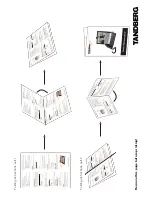
Administrator’s Guide for SIP-T2 Series/T19(P) E2/T4 Series/T5 Series IP Phones
82
Shaping network traffic
Setting traffic priorities across the network
The Best-Effort service is the default QoS model in IP networks. It provides no guarantees for
data delivering, which means delay, jitter, packet loss and bandwidth allocation are
unpredictable. Differentiated Services (DiffServ or DS) is the most widely used QoS model. It
provides a simple and scalable mechanism for classifying and managing network traffic and
providing QoS on modern IP networks. Differentiated Services Code Point (DSCP) is used to
define DiffServ classes and stored in the first six bits of the ToS (Type of Service) field. Each
router on the network can provide QoS simply based on the DiffServ class. The DSCP value
ranges from 0 to 63 with each DSCP specifying a particular per-hop behavior (PHB) applicable to
a packet. A PHB refers to the packet scheduling, queuing, policing, or shaping behavior of a
node on any given packet.
Four standard PHBs available to construct a DiffServ-enabled network and achieve QoS:
Class Selector PHB
-- backwards compatible with IP precedence. Class Selector code
points are of the form “xxx000”. The first three bits are the IP precedence bits. These class
selector PHBs retain almost the same forwarding behavior as nodes that implement IP
precedence-based classification and forwarding.
Expedited Forwarding PHB
-- the key ingredient in DiffServ model for providing a
low-loss, low-latency, low-jitter and assured bandwidth service.
Assured Forwarding PHB
-- defines a method by which BAs (Bandwidth Allocations) can
be given different forwarding assurances.
Default PHB
-- specifies that a packet marked with a DSCP value of “000000” gets the
traditional best effort service from a DS-compliant node.
VoIP is extremely bandwidth and delay-sensitive. QoS is a major issue in VoIP implementations,
regarding how to guarantee that packet traffic not be delayed or dropped due to interference
from other lower priority traffic. VoIP can guarantee high-quality QoS only if the voice and the
SIP packets are given priority over other kinds of network traffic. IP phones support the DiffServ
model of QoS.
Voice QoS
In order to make VoIP transmissions intelligible to receivers, voice packets should not be
dropped, excessively delayed, or made to suffer varying delay. DiffServ model can guarantee
high-quality voice transmission when the voice packets are configured to a higher DSCP value.
SIP QoS
SIP protocol is used for creating, modifying and terminating two-party or multi-party sessions.
To ensure good voice quality, SIP packets emanated from IP phones should be configured with
a high transmission priority.
DSCPs for voice and SIP packets can be specified respectively.
Note
For voice and SIP packets, the IP phone obtains DSCP info from the network policy if LLDP
feature is enabled, which takes precedence over manual settings. For more information on LLDP,
refer to
on page
Содержание SIP-T19 E2 T4 Series
Страница 1: ...63 ...
Страница 532: ...Administrator s Guide for SIP T2 Series T19 P E2 T4 Series T5 Series IP Phones 510 ...
Страница 734: ...Administrator s Guide for SIP T2 Series T19 P E2 T4 Series T5 Series IP Phones 712 ...
Страница 814: ...Administrator s Guide for SIP T2 Series T19 P E2 T4 Series T5 Series IP Phones 792 ...
Страница 850: ...Administrator s Guide for SIP T2 Series T19 P E2 T4 Series T5 Series IP Phones 828 ...
Страница 887: ...Troubleshooting 865 The phone begins rebooting Any reboot of the phone may take a few minutes ...
















































